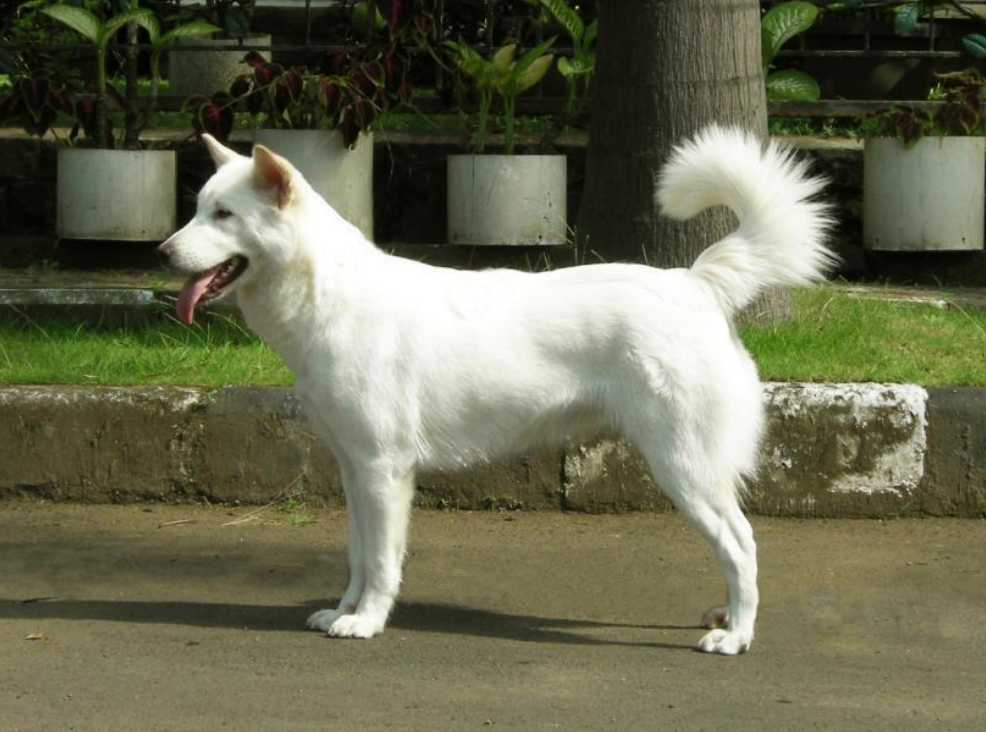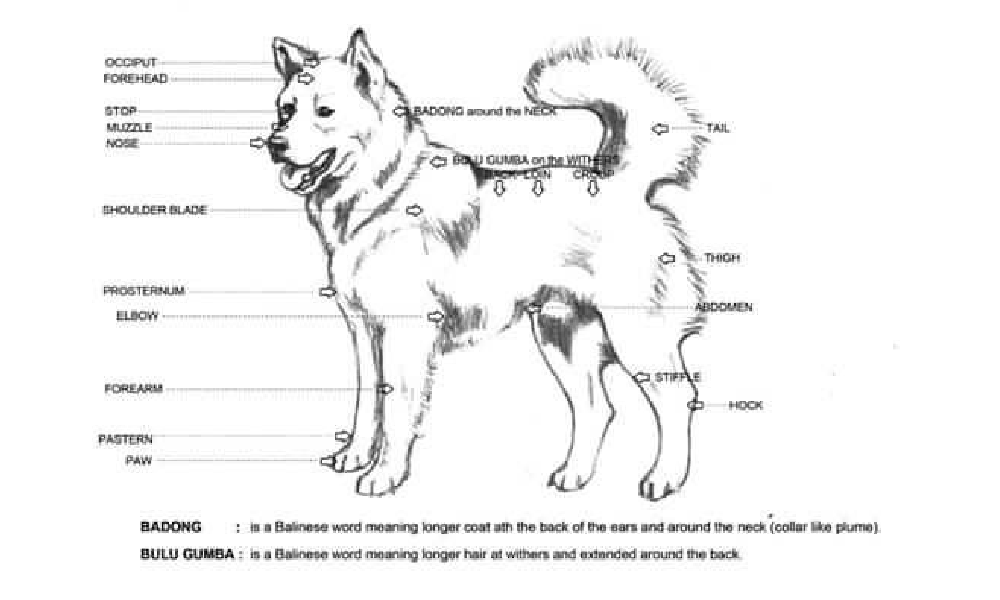DATE OF PUBLICATION OF THE OFFICIAL VALID STANDARD :
13 Juni 2018.
UTILIZATION :
Companion dog
FCI-CLASSIFICATION :
- Group 5 Spitz and primitive type
- Section 5 Asian Spitz and related breeds.
- Without working trial.
BRIEF HISTORICAL SUMMARY :
The Kintamani-Bali Dog is a common household pet in Indonesia. This breed is native from the village of Sukawana in the district of Kintamani in Bali. The Kintamani-Bali Dog comes from the region of mountains, vulcanos and forests. The beginning of Kintamani-Bali Dog is still unknown. Very ancient Lontar Bali, a traditional Balinese documentation, mentioned about Kuluk Gembrong which is believed to be the origin of Kintamani-Bali Dog. In 1985, with the collaboration of the Veterinary Medicine Study Program of Udayana University, the Kintamani-Bali Dog Club of Bali (Pantrab) held its first dog show in Bali. Kintamani-Bali Dog is Republic of Indonesia’s national breed and very popular in the country. Kintamani-Bali Dog has spread throughout Indonesia, and is used as a companion. The name of the breed was given after the region of origin of this dog.
GENERAL APPEARANCE :
Well balanced dog with a rectangular body, a wedge shaped head, moderate stop, pricked ears and a sickle tail with a double-coat, harsh outer coat of medium length on the body and shorter on its face.
IMPORTANT PROPORTIONS :
- Length of body / Height at withers is 11 : 10.
- Females can be slightly longer
- Depth of chest is half of the height at withers.
- Length of muzzle / Length of head is 2 : 5.
- Length of head is 1/4 of body length.
BEHAVIOUR / TEMPERAMENT :
- Watchful,
- intelligent,
- alert,
- gentle,
- loyal and
- easy to train.
HEAD :
CRANIAL REGION :
- Skull : The forehead is broad and wedge shaped.
- Stop : Moderate.
FACIAL REGION: :
- Nose : Broad and well developed. On white with biscuit coloured Kintamani-Bali Dog, nose colour is black or brown. Grey colour is permitted. On black, fawn and brindle Kintamani-Bali Dog, nose colour is black. Nose colour may become lighter with the age.
- Muzzle : Strong, wedge-shaped and tapering.
- Lips : Tight, fully cover-up the lower jaw and dark pigmented.
- Jaws / Teeth : Scissor bite with a complete dentition.
- Cheeks : Relatively well developed.
EYES :
Almond-shaped; well set-in horizontal line at the level of stop. Eyes colour is black or brown, with well pigmented eye lids. Other eye colours are considered as undesirable.
EARS :
Fully erect and triangular in shaped, round-tip and facing front. Set slightly below the top of skull and far apart. Full erected ears is a must after 12 months of age. Edges of ears are biscuit colour for white coloured Kintamani-Bali Dog.
NECK :
Well set into the body, strong, well developed muscular, without dewlap.
BODY :
Rectangular in shape with a leveled top line.
- Top line : Level.
- Withers : Well developed and smooth floating from the neck.
- Back : Straight and strong.
- Loin : Broad and muscular.
- Chest : Well developed. Moderately sprung rib cage, and depth to elbow
- Croup : Broad, of moderate length.
- Underline and belly : Slightly tucked up.
TAILL :
Set in low, on the center of croup with full feathered coat. The ideal shape is curved upward moderately. Full curled is allowed. The end of tail should not drop lower than the level of topline.
LIMBS :
FOREQUARTERS :
- General appearance : Shoulder and upper arm are equal in length. Height to elbow is half height at withers.
- Shoulder : Well layed back.
- Upper Arm : Broad and strongly muscular.
- Elbow : Tight.
- Forearm : Straight and parallel.
- Carpus (Wrist) : Broad.
- Metacarpus (Pastern) : With little inclination.
- Forefeet : The toes are close set, compact, round in shape.
FOREQUARTERS :
- General appearance : Well developed, strong and moderately angulated. Parallel when viewed from the rear.
- Upper Thigh : Broad.
- Stifle (Knee) : Moderated angulated, never be too close to the paracentral part of the body
- Lower Thigh : Strong and muscular.
- Hock : Medium length and perpendicular to the ground.
- Metatarsus (Rear Pastern): Broad, flat when viewed from the side.
- Hind feet : The toes are close set, compact, and round in shape.
GAIT / MOVEMENT :
Resilient and light with good reach and drive.
COAT :
Hair: Double-coat; soft under-coat is relatively short, harsh outercoat is medium length along the sides of body. The neck and withers are surrounded with long harsh outer-coat. Full-feathered tail. (The longer length outer coat around the neck is called “BADONG”, and forms a ruff around the neck. The longer coat at withers which extend around the back is called “BULU GUMBA”, “BADONG” and “BULU GUMBA” is more visible on the males rather than the females).
Colour :
- White : White with biscuit coloured ear edge. White without biscuit coloured ear edge is accepted but not preferred. Nose is black or brown.
- Black : Full black. Small amount of white on the chest, toes and/or at tip of tail is permissible. Nose is black.
- Fawn : Fawn comes in various shades, from light fawn to deep red. Black mask is preferred. Nose is black. Small amount of white on the chest, toes or tip of tail is allowed.
- Brindle : Fawn background of various shades from light fawn to deep red as base colour, with dark or black stripes. Black mask is preferred. Nose is black. Small amount of white on the chest, toes or tip of tail is allowed.
SIZE AND WEIGHT :
Height at withers :
- Males : 49 - 57 cm. Preferred at 53 cm.
- Females : 44 - 52 cm. Preferred at 48 cm.
Weight :
- Males : 15 - 18 kg.
- Females : 13 - 16 kg.
FAULTS :
Any departure from the foregoing points should be considered a fault and the seriousness with which the fault should be regarded should be in exact proportion to its degree and its effect upon the health and welfare of the dog
- Lack of sexual demorphism.
- Any missing tooth (except PM1 and/or M3).
- Eyes too light in colour.
SEVERE FAULTS: :
Curled-tail which drops below the topline.
DISQUALIFYING FAULTS :
- Aggressive or overly shy dogs.
- Any dog clearly showing physical or behavioural abnormalities.
- Overshot or undershot.
- Thin coat on tail.
- Ears not erect at 12 months and older.
- Unpigmented eye lids.
- Any other colour not mentioned in this standard.
N.B.
- Male animals should have two apparently normal testicles fully descended into the scrotum.
- Only functionally and clinically healthy dogs, with breed typical conformation should be used for breeding.


